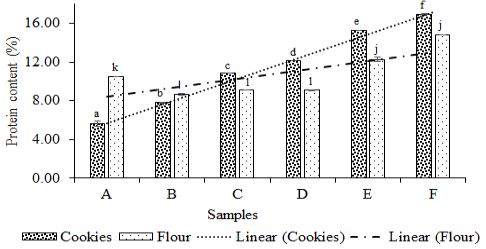Evaluation of the quality characteristics of cookies produced from blends of tigernut and soybean flour
DOI:
https://doi.org/10.54117/ijnfs.v3i1.38Keywords:
Cookies, tigernut flour, soybean flour, protein, physicochemical, functional and sensory propertiesAbstract
This study investigated the physicochemical, functional and protein content of tigernut-soybean flour blends with the protein and sensory properties of cookies from the flour blends. Tigernut (Cyperus esculentus) and soybean (Glycine max) was mixed in the ratio of 90:10, 80:20, 70:30, 60:40, 50:50, coded as sample B, C, D, E and F respectively, while 100% wheat flour (sample A) served as control. All the analysis was carried out using standard analytical procedures. pH, total titratable acidity (% lactic acid), viscosity and total soluble solids (oBrix) ranged respectively, from 4.21 - 5.37, 0.021 - 0.039, 9.43 - 2.18 and 1.00 - 4.50% sugar. Least gelation capacity, oil absorption capacity, water absorption capacity, bulk density, dispersibility, swelling power, solubility and foaming capacity ranged from 0.10 - 0.50%, 1.64 - 1.81g/g, 1.23 - 2.13g/g, 0.45 - 0.55g/g, 31.00-36.00%, 3.87 - 5.68g/g, 13.59 - 29.32% and 15.00 - 25.00%for There was significant (p<0.05) increase in protein content of the flour (8.68 – 14.81%) and cookies (7.81 – 16.94%) with increase in soybean. Cookies produced from 60:40 % tigernut-soybean flour (sample E) had the highest degree of likeness for colour, aroma, appearance and overall acceptability in the range of like slightly to like moderately. The increase in protein and degree of likeness of the tigernut-soybean cookies suggests that the flour blends can substitute for wheat flour at levels of 70:30 and 60:40% in the production of acceptable cookies of nutritional quality.

Downloads
Published
How to Cite
Issue
Section
License
Copyright (c) 2024 Patience Chisa Obinna-Echem, Allbright O. Amadi, Siyeofori A Ogan

This work is licensed under a Creative Commons Attribution 4.0 International License.
